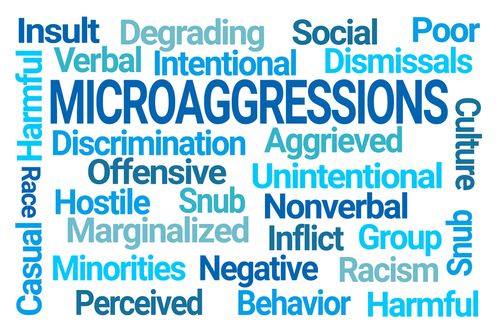 One of the main goals of the church is to welcome people who are looking for a community with which to explore their faith. Many organizations are starting to recognize the importance of offering inclusion training for their staff and lay leaders, and their congregations are often invited to attend as well. Most people enter this training with the understanding that they are likely to have hard conversations.
One of the main goals of the church is to welcome people who are looking for a community with which to explore their faith. Many organizations are starting to recognize the importance of offering inclusion training for their staff and lay leaders, and their congregations are often invited to attend as well. Most people enter this training with the understanding that they are likely to have hard conversations.
What some of them don't expect is to see their own behavior reflected in the list of things to avoid doing or saying. When this happens, it's usually because they've been confronted with the concept of microaggressions. A microaggression can be any word or gesture that communicates bias. Microaggressions may seem small and harmless and they are often unintentional, but over time, their impact can really add up. Understanding the effect they can have is a crucial part of communicating with sensitivity and ultimately becoming a more welcoming community.
Types
One of the difficulties in recognizing microaggressions is that they are often so embedded in the culture's language and mindset that unless they have an impact on you personally, you may not even notice that they're happening. The more you read and the more examples you are given, however, the easier it becomes to recognize these infractions. There are many different ways that microaggressions occur, but most of them fall within three main categories:
- Microassault - Using terms or symbols that have a derogatory meaning
- Microinsult - Making assumptions based on a person's race, ethnicity, sexual orientation, gender expression, etc.
- Microinvalidation - Ignoring or erasing someone's experience
Microassaults
A microassault is not usually as blatant as an outright slur, but it can have a similar effect. It can even be a term that was once considered socially acceptable or culturally sensitive. For example, asking for people's preferred pronouns at one time was an acknowledgment that one cannot assume male or female gender. The qualifier "preferred," however, can imply that their gender is merely a choice, not something inherent in their identity. It is more inclusive to inquire about personal pronouns or to drop the adjective altogether and simply ask for their pronouns when meeting new people.
Microinsults
One of the most subtle forms of microaggression is a microinsult. Prejudices are often as hidden as other motivations, sometimes even from the person who holds them. It is easy to pretend (or even actually believe) that there is nothing wrong with some microinsults because their meaning is typically dependent on the context in which they are said. For example, there's nothing inherently wrong with trying to hire the most qualified candidate for a job. However, making a point to state this standard as your intention in an interview with a candidate of another ethnicity or using it to justify only looking at certain qualifications rather than the big picture can be problematic.
Microinvalidations
The difficulty with addressing microinvalidations is that people who use them often mean to come across as unifying. Saying, "I don't see color," when a friend expresses concern that he or she may be discriminated against is usually an attempt to comfort or reassure. Unfortunately, it often has the exact opposite effect. If someone claims to not see color, especially in situations where other people are sharing their lived experience of racial prejudice, this statement sounds more like a dismissal of their viewpoint. Rather than trying to center themselves by pointing out that they don't actively discriminate, their time during these conversations would be better spent listening to the perspectives of BIPOC and learning the impact of words and actions on them.
Exploring ways to put your church's inclusive values into regular practice is important. Any comprehensive program should include recognizing and understanding the impact of microaggressions.



